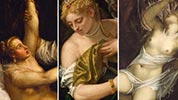Archaeology and Ancient History
Anna-Sophie's dissertation
The Representation and Transformation of Lucretia from Livy’s Ab Urbe Condita in Sixteenth-Century Italian Renaissance Paintings
Why did you choose this topic?
After having done Dr Sarah Scott's third year module on Greek and Roman Art in Ancient and Modern Contexts, I became interested in past approaches to the classical past. I especially wanted to look at how we have transformed stories from ancient literary texts into visual representations, such as Lucretia's rape, and how different social and political contexts affect representations and viewer interpretations. Additionally, I became interested in past gendered social values and power relationships and how some of these are still prevalent today, making the story of Lucretia very suitable.
What did you write about?
 My thesis was a comparative analysis between Lucretia's story from Livy's Ab Urbe Condita and the visual representations and transformations of her in the paintings of three sixteenth-century Venetian Renaissance painters: Titian, Tintoretto and Veronese.
My thesis was a comparative analysis between Lucretia's story from Livy's Ab Urbe Condita and the visual representations and transformations of her in the paintings of three sixteenth-century Venetian Renaissance painters: Titian, Tintoretto and Veronese.
It sought to find out what Renaissance viewers, male and female, were supposed to feel when viewing one of these paintings in their original context. It became clear that there was no one true interpretation for these paintings; one viewer could look at them and be outraged with the nudity of the figures, feel sympathy for Lucretia's story or titillation from the erotic aspects of it. It was thus difficult to determine whether Lucretia's image was used for moral teaching, instilling patriarchal values or erotic stimulation.
Moreover, I questioned whether women would have passively accepted these messages, but since they were created through a male patronage system and there are no surviving records of female reactions towards them, we can again only speculate. Still, this topic has been worthy of investigation as it brought to light how representations of Lucretia could have transmitted gendered beliefs and neutralised the viewing of sexual, and sometimes violent, scenes.
Too often paintings such as these are viewed without a context-specific approach, not considering their original meaning and context. The modern viewer instead views them solely as aesthetic objects and admires them for their aesthetic value and artistic skill, not analysing the portrayal of their inherent gendered values and power relations, such as honour, chastity, and rape and shame culture.
The violent and social implications of the portrayal of Lucretia's rape and suicide and similar stories have thus become invisible to most since Renaissance artists sanitised and idealised representations of rape and suicide by portraying bodies that were beautiful, ideal and intact. Therefore, it showed that it is important to critically analyse and view such paintings, as it helps to understand where gendered ideology originates from, how it has been passed down, and how it persists.